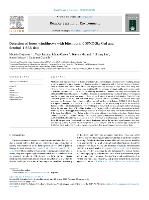Detection of forest windthrows with bitemporal COSMO-SkyMed and Sentinel-1 SAR data
Fecha
2023-08-29Autor(es)
Dalponte, Michele
Solano-Correa, Yady Tatiana
Marinelli, Daniele
Liu, Sicong
Yokoya, Naoto
Gianelle, Damiano
Metadatos
Mostrar el registro completo del ítemResumen
Wind represents a primary source of disturbances in forests, necessitating an assessment of the resulting damage to ensure appropriate forest management. Remote sensing, encompassing both active and passive techniques, offers a valuable and efficient approach for this purpose, enabling coverage of large areas while being cost-effective. Passive remote sensing data could be affected by the presence of clouds, unlike active systems such as Synthetic Aperture Radar (SAR) which are relatively less affected. Therefore, this study aims to explore the utilization of bitemporal SAR data for windthrow detection in mountainous regions. Specifically, we investigated how the detection outcomes vary based on three factors: i) the SAR wavelength (X-band or C-band), ii) the acquisition period of the pre- and post-event images (summer, autumn, or winter), and iii) the forest type (evergreen vs. deciduous). Our analysis considers two SAR satellite constellations: COSMO-SkyMed (band-X, with a pixel spacing of 2.5 m and 10 m) and Sentinel-1 (band-C, with a pixel spacing of 10 m). We focused on three study sites located in the Trentino-South Tyrol region of Italy, which experienced significant forest damage during the Vaia storm from 27th to 30th October 2018. To accomplish our objectives, we employed a detail-preserving, scale-driven approach for change detection in bitemporal SAR data. The results demonstrate that: i) the algorithm exhibits notably better performance when utilizing X-band data, achieving a highest kappa accuracy of 0.473 and a balanced accuracy of 76.1%; ii) the pixel spacing has an influence on the accuracy, with COSMO-SkyMed data achieving kappa values of 0.473 and 0.394 at pixel spacings of 2.5 m and 10 m, respectively; iii) the post-event image acquisition season significantly affects the algorithm's performance, with summer imagery yielding superior results compared to winter imagery; and iv) the forest type (evergreen vs. deciduous) has a noticeable impact on the results, particularly when considering autumn/winter data.
Citar como
Dalponte, M., Solano-Correa, Y. T., Marinelli, D., Liu, S., Yokoya, N., & Gianelle, D. (2023). Detection of forest windthrows with bitemporal COSMO-SkyMed and Sentinel-1 SAR data. Remote Sensing of Environment, 297, 113787. https://doi.org/10.1016/j.rse.2023.113787Utilice esta dirección para citar:
https://hdl.handle.net/20.500.12585/12475Colecciones
- Productos de investigación [1453]
Compatible para recolección con:

Archivos
El ítem tiene asociados los siguientes ficheros de licencia:
Universidad Tecnológica de Bolívar - 2017 Institución de Educación Superior sujeta a inspección y vigilancia por el Ministerio de Educación Nacional. Resolución No 961 del 26 de octubre de 1970 a través de la cual la Gobernación de Bolívar otorga la Personería Jurídica a la Universidad Tecnológica de Bolívar.













